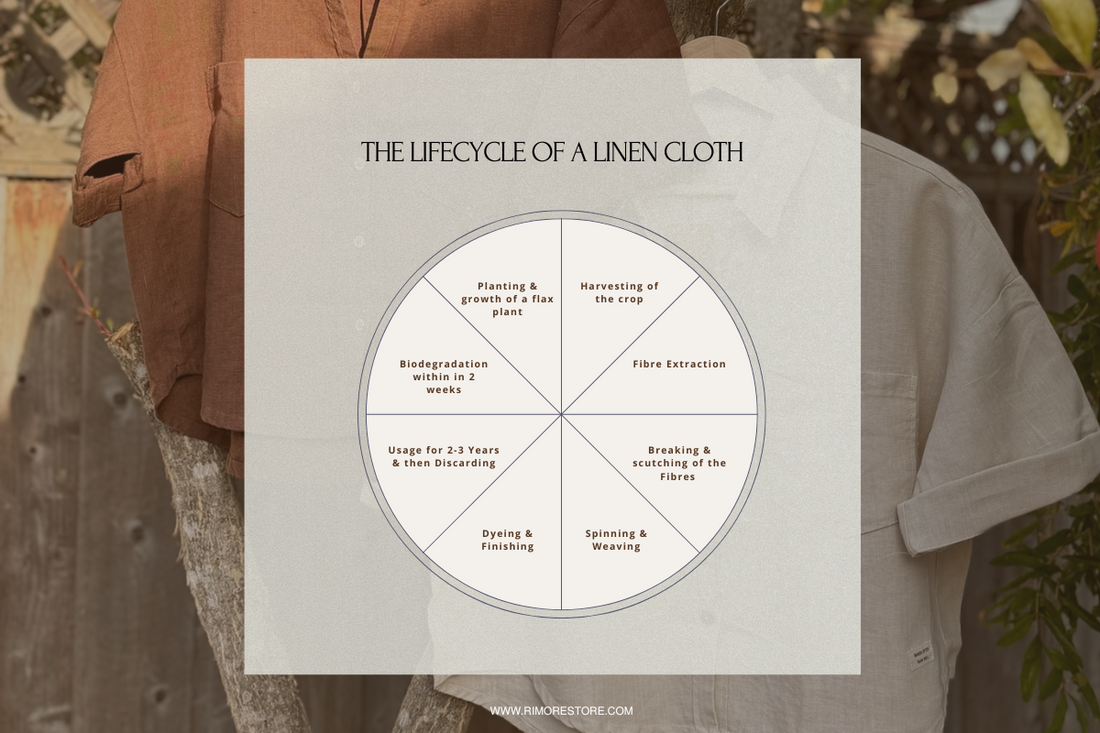
The Journey of Linen: From Flax Plant to Fashionable Attire
Share
Ever wonder how that beautiful linen shirt in your closet started its life? It's actually quite a fascinating story that begins with a humble plant called flax. Let me take you on this amazing journey from field to fashion – it's a tale of tradition, craftsmanship, and sustainability that might just make you love your linen pieces even more.
Step 1: It All Starts in the Field
Picture this: Fields of beautiful blue-flowered flax plants swaying in the breeze, particularly in places like Belgium, France, and the Netherlands. What's really cool about flax is that it's kind of a superstar in the sustainability world. It doesn't need much water to grow, you can use every single part of the plant (even the seeds become nutritious linseed oil!), and it naturally fights off pests without needing harsh chemicals. Pretty impressive for a humble plant, right?
Step 2: Harvest Time – The Gentle Uprooting
Here's where things get interesting. Unlike other crops that get cut down, flax plants are actually pulled up from the ground, roots and all. Why? Because those long, unbroken fibers are pure gold when it comes to making high-quality linen. Then comes this fascinating process called retting – basically letting nature do its thing to break down the stalks and release the fibers. Some farmers let the morning dew do the work, while others soak the plants in water. It's like a slow-cooking recipe – you can't rush perfection!
Step 3: Getting to the Good Stuff
Once the stalks are broken down, it's time to get those precious fibers out. Think of it like combing hair – first, they break the woody parts, then scrape away the leftovers, and finally comb through to separate the long, luxury-grade fibers from the shorter ones. The long ones? They're destined for your favorite linen clothes. The shorter ones still get used for other things – nothing goes to waste!
Step 4: The Art of Spinning
This is where science meets art. Those extracted fibers get spun into yarn, and while we've got modern machines doing this now, it's still a craft that requires real skill. The result is this beautifully imperfect yarn with a natural shine that's surprisingly strong. Those little irregularities? They're what give linen its characteristic charm.
Step 5: Weaving Magic
Now we're getting to the good part! The yarn gets woven into fabric on looms, creating different patterns depending on what the final use will be. You've got your basic weave for everyday items, fancy damask patterns for special pieces, and twill weaves that add a bit of softness and flexibility. Each type has its own personality and purpose.
Step 6: The Final Touches
Think of this stage as linen's spa treatment. The fabric gets cleaned up, maybe bleached if it's going to be dyed, and then softened to give it that lovely feel we all love. It's like giving the fabric its final polish before it heads out into the world.
Step 7: Becoming Fashion
Finally, this carefully crafted fabric makes its way to designers who transform it into everything from breezy summer dresses to sharp suits. And here's the best part – because linen is so durable, these pieces aren't just going to last one season. They're in it for the long haul.
Why This Process Matters
What makes this whole journey so special is how sustainable it is. Every step, from growing the flax to the final product, works with nature rather than against it. And when a linen piece finally reaches the end of its life? It simply returns to the earth, breaking down naturally without leaving any nasty chemicals behind.
The Real Beauty of Linen
Beyond all the technical stuff, there's something really special about linen. It's not just a fabric; it's a story of craftsmanship that's been passed down through generations. It keeps you cool when it's hot, gets softer with every wash, and somehow manages to look even better with age (those natural wrinkles are part of its charm!).
When you choose linen, you're not just picking a fabric – you're becoming part of a story that goes back thousands of years, and hopefully, forward into a more sustainable future. Pretty cool for something that started as a simple plant in a field, don't you think?
So next time you put on your favorite linen piece, remember its incredible journey. From a tiny seed to the clothes on your back, it's a testament to nature's ingenuity and human craftsmanship working together to create something truly special.
